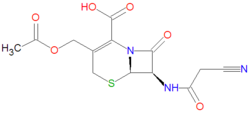Cefacetrile: Difference between revisions
imported>David E. Volk (New page: {{subpages}} {{Chem infobox |align=right |image=center|thumb|250px|{{#ifexist:Template:Cefadroxil.jpg/credit|{{Cefadroxil.jpg/credit}}<br/>|}} |width=250px |molna...) |
mNo edit summary |
||
| Line 24: | Line 24: | ||
== References == | == References == | ||
<references/> | <references/> | ||
{{CZMed}} | {{CZMed}}[[Category:Suggestion Bot Tag]] | ||
Latest revision as of 16:01, 25 July 2024
|
| |||||||
| cefacetrile | |||||||
| |||||||
| Uses: | antibiotic drug | ||||||
| Properties: | beta-lactam | ||||||
| Hazards: | see drug interactions | ||||||
| |||||||
Cefacetrile is a first-generation cephalosporin antibiotic medication used to treate bacterial infections. It is sold under the brand names Celospor®, Celtol® and Cristacef®. It a 7-cyanacetylamino derivative of cephalosporic acid, and is also called by the synonyms cefacetrilo, cefacetrilum and cephacetrile.
Chemistry
The IUPAC name of cefacetrile is (6R,7R)-3-(acetyloxymethyl)-7-[(2-cyanoacetyl)amino]-8-oxo-5-thia-1-azabicyclo[4.2.0]oct-2-ene-2-carboxylic acid, and its chemical formula, C13H13N3O6S, yields an average molecular mass of 339.3240 gram/mole. Its antibacterial activity is due to the presence of a beta-lactam core structure, which bind with penicillin-binding proteins within bacterial cells, thereby inhibiting cell wall synthesis in bacteria.
References
The most up-to-date information about Cefacetrile and other drugs can be found at the following sites.
- Cefacetrile - FDA approved drug information (drug label) from DailyMed (U.S. National Library of Medicine).
- Cefacetrile - Drug information for consumers from MedlinePlus (U.S. National Library of Medicine).
- Cefacetrile - Detailed information from DrugBank.
